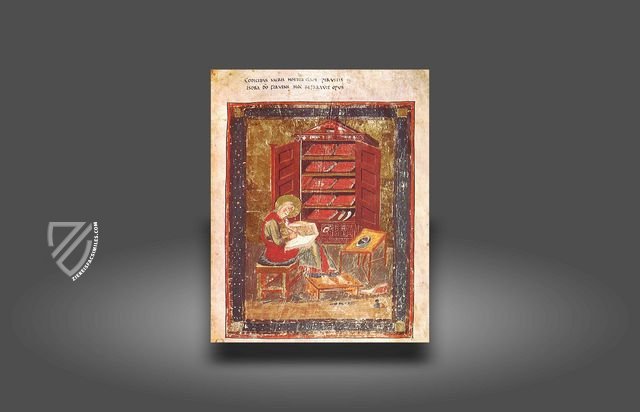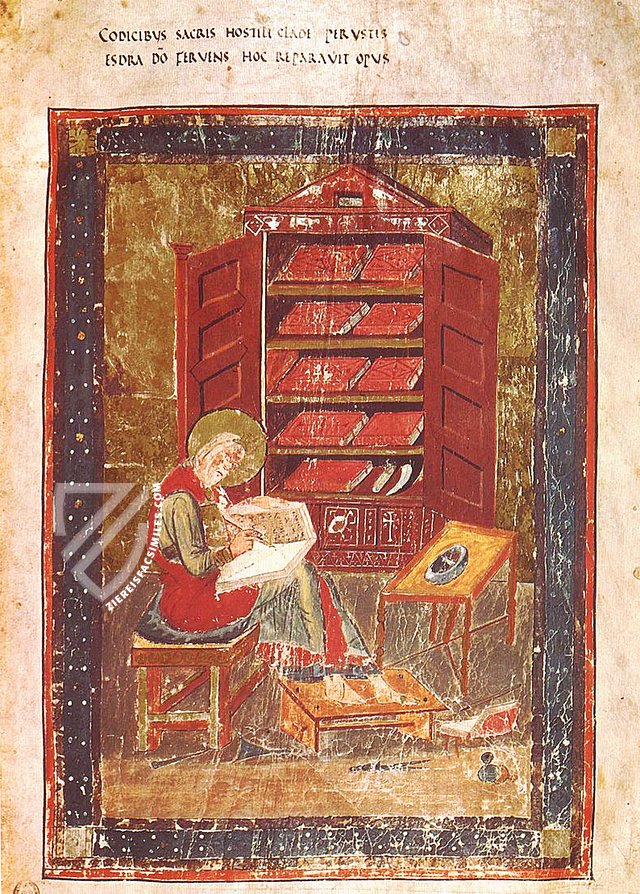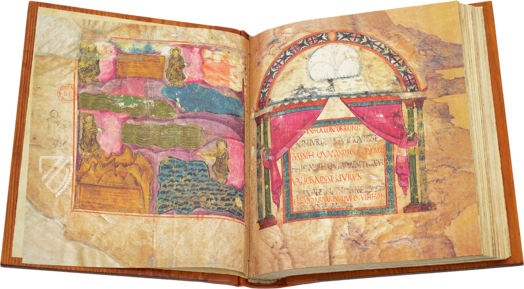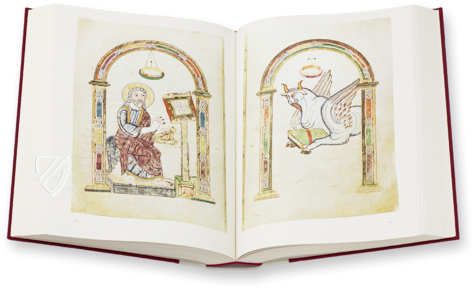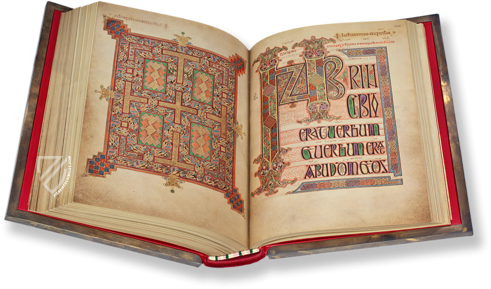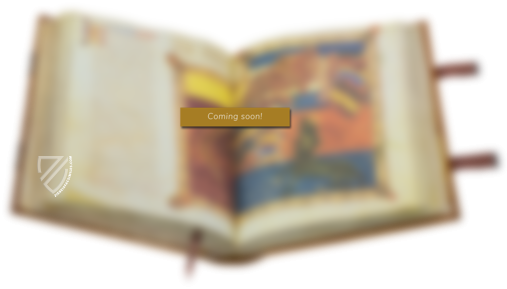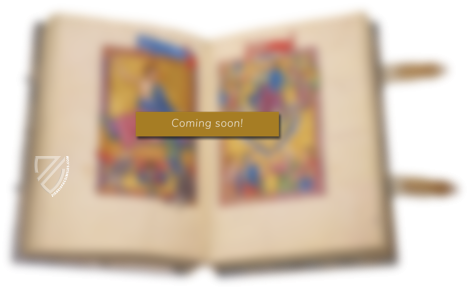Codex Amiatinus
(3,000€ - 7,000€)
The Codex Amiatinus is the oldest surviving version of the Bible to contain the complete Vulgate text as written by St. Jerome, originating from Anglo-Saxon England ca. 700. It is also the oldest single-volume Bible to survive to the present. Originally sent to Rome as a gift to the Pope, the manuscript spent most of its life in the library of the Abbey of the Savior on Mount Amiata, Tuscany, which is the origin of its name. It represents the most reliable transcription of St. Jerome’s magnum opus, making it invaluable to theologians and art historians alike.
Codex Amiatinus
In the late-4th century, St. Jerome (347-420) completed an authoritative Latin Translation of the Bible at the behest of Pope Damasus I (ca. 305–384), which is known as the Vulgate. It gradually came to replace an earlier Latin translation by the 13th century and was reaffirmed by the Council of Trent (1545–63) as the official Latin Bible, even though there was not an authoritative edition at the time. The so-called “Clementine edition” became the standard in 1592 and remained so until the promulgation of the Nova Vulgata in 1979. The provenance of the manuscript at hand, the Codex Amiatinus, has long been debated with scholars claiming it originated in places as far apart as northern England and Southern Italy. It is named after Mount Amiata in Tuscany, where it was long stored in the Abbazia di San Salvatore Abbey. What is uncontested is the fact that this is the oldest surviving complete manuscript of the Vulgate version of the Bible as well as the oldest single-volume Bible. Only the incomplete 7th century León Palimpsest is older. Furthermore, it represents the most reliable transcription of St. Jerome’s magnum opus, making it invaluable to theologians and art historians alike. This massive tome measures 54 x 33.5 cm, contains over 1,000 leaves, and weighs 50 kilograms!
A Contested Provenance
Determining the origins of the Codex Amiatinus has been complicated by the fact that the dedication page has been altered. Angelo Maria Bandini (1726–1803), principal librarian of Florence’s famous Laurentian Library, theorized that Servandus, a follower of St. Benedict (ca. 480 – ca. 547), was responsible for the manuscript and that it was created ca. 540 in Montecassino Abbey, a center of art and culture. Accepted for the next hundred years, this hypothesis was eventually disproven by German scholars, who first noticed similarities to texts from the 9th century. Finally, Giovanni Battista de Rossi (1822–94), an Italian archeologist, determined in 1888 that this manuscript was one of three copies of the Bible commissioned in 692 by Abbot Ceolfrid (ca. 642–716), who was then in charge of Monkwearmouth–Jarrow Abbey, a double Benedictine monastery in the Anglo-Saxon Kingdom of Northumbria. One of the reasons for this confusion is that the two full-page miniatures in the manuscript do not exhibit the typical aesthetic of Insular Illumination, but are clearly modeled on examples from Late Antiquity, a style popular in the scriptorium of Montecassino. The fact of this unusual artistic program makes the manuscript all the more unique.
The Bible’s 1,300-Year Journey
The three commissions of the Abbot Ceolfrid were so vast in size that the abbey had to acquire additional lands to raise the 2,000 head of cattle required to produce the necessary amount of vellum. Originating from ca. 700, the Codex Amiatinus can certainly be regarded as the oldest Vulgate Bible and the oldest surviving single-volume Latin Bible. Ceolfrid intended to personally present the manuscript to Pope Gregory II, but he died en route on September 29th, 716 while in Burgundy. The manuscript found itself in the library of the Abbey of the Savior on Mount Amiata, Tuscany beginning in the 9th century, where it remained until 1786, when it became part of the holdings of the Laurentian Library in Florence. During this time, in 1586 to be precise, Pope Sixtus V (1521–90) had the manuscript sent to Rome to be consulted by scholars for a new, authoritative Latin translation, but it actually appears to have been used very little for the creation of the new Vulgata Sixtina. The Codex Amiatinus did play a critical role in subsequent attempts to correct the accumulated mistakes of the Vulgate, first by the eventual Bishop of Salisbury John Wordsworth (1843–1911) and again in 1907 by a team of Benedictine monks commissioned by Pope Pius X (1835–1914) with creating a critical new edition of St. Jerome’s Vulgate. After 1,302 years, the manuscript finally returned to England in 2017 for an exhibition of Anglo-Saxon manuscripts in the British library. Such is the life of one of the oldest and most important biblical manuscripts in the world.
Codicology
- Alternative Titles
- La Bibbia Amiatina
Codice Amiatino - Size / Format
- 2058 pages / 51.0 × 34.0 cm
- Origin
- United Kingdom
- Date
- 700–715
- Epochs
- Style
- Genre
- Language
- Script
- Roman uncial Roman rustic capitals
- Illustrations
- 2 full-page miniatures, 7 illuminated canon tables, 4 additional illuminated pages, 9 calligraphic initials, 3 lettering schemes
- Content
- Vulgate with auxiliary texts and prologues
- Patron
- Abbot Ceolfrith
- Previous Owners
- Gregory II
Abbey of San Salvatore on Monte Amiata
#1 La Bibbia Amiatina
(3,000€ - 7,000€)
- Treatises / Secular Books
- Apocalypses / Beatus
- Astronomy / Astrology
- Bestiaries
- Bibles / Gospels
- Chronicles / History / Law
- Geography / Maps
- Saints' Lives
- Islam / Oriental
- Judaism / Hebrew
- Single Leaf Collections
- Leonardo da Vinci
- Literature / Poetry
- Liturgical Manuscripts
- Medicine / Botany / Alchemy
- Music
- Mythology / Prophecies
- Psalters
- Other Religious Books
- Games / Hunting
- Private Devotion Books
- Other Genres
- Afghanistan
- Armenia
- Austria
- Belgium
- Belize
- Bosnia and Herzegovina
- China
- Colombia
- Costa Rica
- Croatia
- Cyprus
- Czech Republic
- Denmark
- Egypt
- El Salvador
- Ethiopia
- France
- Germany
- Greece
- Guatemala
- Honduras
- Hungary
- India
- Iran
- Iraq
- Israel
- Italy
- Japan
- Jordan
- Kazakhstan
- Kyrgyzstan
- Lebanon
- Liechtenstein
- Luxembourg
- Mexico
- Morocco
- Netherlands
- Palestine
- Panama
- Peru
- Poland
- Portugal
- Romania
- Russia
- Serbia
- Spain
- Sri Lanka
- Sweden
- Switzerland
- Syria
- Tajikistan
- Turkey
- Turkmenistan
- Ukraine
- United Kingdom
- United States
- Uzbekistan
- Vatican City
- A. Oosthoek, van Holkema & Warendorf
- Aboca Museum
- Ajuntament de Valencia
- Akademie Verlag
- Akademische Druck- u. Verlagsanstalt (ADEVA)
- Aldo Ausilio Editore - Bottega d’Erasmo
- Alecto Historical Editions
- Alkuin Verlag
- Almqvist & Wiksell
- Amilcare Pizzi
- Andreas & Andreas Verlagsbuchhandlung
- Archa 90
- Archiv Verlag
- Archivi Edizioni
- Arnold Verlag
- ARS
- Ars Magna
- ArtCodex
- AyN Ediciones
- Azimuth Editions
- Badenia Verlag
- Bärenreiter-Verlag
- Belser Verlag
- Belser Verlag / WK Wertkontor
- Benziger Verlag
- Bernardinum Wydawnictwo
- BiblioGemma
- Biblioteca Apostolica Vaticana (Vaticanstadt, Vaticanstadt)
- Bibliotheca Palatina Faksimile Verlag
- Bibliotheca Rara
- Boydell & Brewer
- Bramante Edizioni
- Bredius Genootschap
- Brepols Publishers
- British Library
- C. Weckesser
- Caixa Catalunya
- Canesi
- CAPSA, Ars Scriptoria
- Caratzas Brothers, Publishers
- Carus Verlag
- Casamassima Libri
- Centrum Cartographie Verlag GmbH
- Chavane Verlag
- Christian Brandstätter Verlag
- Circulo Cientifico
- Club Bibliófilo Versol
- Club du Livre
- CM Editores
- Collegium Graphicum
- Collezione Apocrifa Da Vinci
- Comissão Nacional para as Comemorações dos Descobrimentos Portugueses
- Coron Verlag
- Corvina
- CTHS
- D. S. Brewer
- Damon
- De Agostini/UTET
- De Nederlandsche Boekhandel
- De Schutter
- Deuschle & Stemmle
- Deutscher Verlag für Kunstwissenschaft
- DIAMM
- Droz
- E. Schreiber Graphische Kunstanstalten
- Ediciones Boreal
- Ediciones Grial
- Ediclube
- Edições Inapa
- Edilan
- Editalia
- Edition Deuschle
- Edition Georg Popp
- Edition Leipzig
- Edition Libri Illustri
- Editiones Reales Sitios S. L.
- Éditions de l'Oiseau Lyre
- Editions Medicina Rara
- Editorial Casariego
- Editorial Mintzoa
- Editrice Antenore
- Editrice Velar
- Edizioni Edison
- Egeria, S.L.
- Eikon Editores
- Electa
- Emery Walker Limited
- Enciclopèdia Catalana
- Eos-Verlag
- Ephesus Publishing
- Ernst Battenberg
- Eugrammia Press
- Extraordinary Editions
- Fackelverlag
- Facsimila Art & Edition
- Facsimile Editions Ltd.
- Facsimilia Art & Edition Ebert KG
- Faksimile Verlag
- Feuermann Verlag
- Folger Shakespeare Library
- Franco Cosimo Panini Editore
- Friedrich Wittig Verlag
- Fundación Hullera Vasco-Leonesa
- G. Braziller
- Gabriele Mazzotta Editore
- Gebr. Mann Verlag
- Gesellschaft für graphische Industrie
- Getty Research Institute
- Giovanni Domenico de Rossi
- Giunti Editore
- Graffiti
- Grafica European Center of Fine Arts
- Guido Pressler
- Guillermo Blazquez
- Gustav Kiepenheuer
- H. N. Abrams
- Harrassowitz
- Harvard University Press
- Helikon
- Hendrickson Publishers
- Henning Oppermann
- Herder Verlag
- Hes & De Graaf Publishers
- Hoepli
- Holbein-Verlag
- Houghton Library
- Hugo Schmidt Verlag
- Idion Verlag
- Il Bulino, edizioni d'arte
- ILte
- Imago
- Insel Verlag
- Insel-Verlag Anton Kippenberger
- Instituto de Estudios Altoaragoneses
- Instituto Nacional de Antropología e Historia
- Introligatornia Budnik Jerzy
- Istituto dell'Enciclopedia Italiana - Treccani
- Istituto Ellenico di Studi Bizantini e Postbizantini
- Istituto Geografico De Agostini
- Istituto Poligrafico e Zecca dello Stato
- Italarte Art Establishments
- Jan Thorbecke Verlag
- Johnson Reprint Corporation
- Josef Stocker
- Josef Stocker-Schmid
- Jugoslavija
- Karl W. Hiersemann
- Kasper Straube
- Kaydeda Ediciones
- Kindler Verlag / Coron Verlag
- Kodansha International Ltd.
- Konrad Kölbl Verlag
- Kurt Wolff Verlag
- La Liberia dello Stato
- La Linea Editrice
- La Meta Editore
- Lambert Schneider
- Landeskreditbank Baden-Württemberg
- Leo S. Olschki
- Les Incunables
- Liber Artis
- Library of Congress
- Libreria Musicale Italiana
- Lichtdruck
- Lito Immagine Editore
- Lumen Artis
- Lund Humphries
- M. Moleiro Editor
- Maison des Sciences de l'homme et de la société de Poitiers
- Manuscriptum
- Martinus Nijhoff
- Maruzen-Yushodo Co. Ltd.
- MASA
- Massada Publishers
- McGraw-Hill
- Metropolitan Museum of Art
- Militos
- Millennium Liber
- Müller & Schindler
- Nahar - Stavit
- Nahar and Steimatzky
- National Library of Wales
- Neri Pozza
- Nova Charta
- Oceanum Verlag
- Odeon
- Orbis Mediaevalis
- Orbis Pictus
- Österreichische Staatsdruckerei
- Oxford University Press
- Pageant Books
- Parzellers Buchverlag
- Patrimonio Ediciones
- Pattloch Verlag
- PIAF
- Pieper Verlag
- Plon-Nourrit et cie
- Poligrafiche Bolis
- Presses Universitaires de Strasbourg
- Prestel Verlag
- Princeton University Press
- Prisma Verlag
- Priuli & Verlucca, editori
- Pro Sport Verlag
- Propyläen Verlag
- Pytheas Books
- Quaternio Verlag Luzern
- Reales Sitios
- Recht-Verlag
- Reichert Verlag
- Reichsdruckerei
- Reprint Verlag
- Riehn & Reusch
- Roberto Vattori Editore
- Rosenkilde and Bagger
- Roxburghe Club
- Salerno Editrice
- Saltellus Press
- Sandoz
- Sarajevo Svjetlost
- Schöck ArtPrint Kft.
- Schulsinger Brothers
- Scolar Press
- Scrinium
- Scripta Maneant
- Scriptorium
- Shazar
- Siloé, arte y bibliofilia
- SISMEL - Edizioni del Galluzzo
- Sociedad Mexicana de Antropología
- Société des Bibliophiles & Iconophiles de Belgique
- Soncin Publishing
- Sorli Ediciones
- Stainer and Bell
- Studer
- Styria Verlag
- Sumptibus Pragopress
- Szegedi Tudomànyegyetem
- Taberna Libraria
- Tarshish Books
- Taschen
- Tempus Libri
- Testimonio Compañía Editorial
- Thames and Hudson
- The Clear Vue Publishing Partnership Limited
- The Facsimile Codex
- The Folio Society
- The Marquess of Normanby
- The Richard III and Yorkist History Trust
- Tip.Le.Co
- TouchArt
- TREC Publishing House
- TRI Publishing Co.
- Trident Editore
- Tuliba Collection
- Typis Regiae Officinae Polygraphicae
- Union Verlag Berlin
- Universidad de Granada
- University of California Press
- University of Chicago Press
- Urs Graf
- Vallecchi
- Van Wijnen
- VCH, Acta Humaniora
- VDI Verlag
- VEB Deutscher Verlag für Musik
- Verlag Anton Pustet / Andreas Verlag
- Verlag Bibliophile Drucke Josef Stocker
- Verlag der Münchner Drucke
- Verlag für Regionalgeschichte
- Verlag Styria
- Vicent Garcia Editores
- W. Turnowski Ltd.
- W. Turnowsky
- Waanders Printers
- Wiener Mechitharisten-Congregation (Wien, Österreich)
- Wissenschaftliche Buchgesellschaft
- Wissenschaftliche Verlagsgesellschaft
- Wydawnictwo Dolnoslaskie
- Xuntanza Editorial
- Zakład Narodowy
- Zollikofer AG

